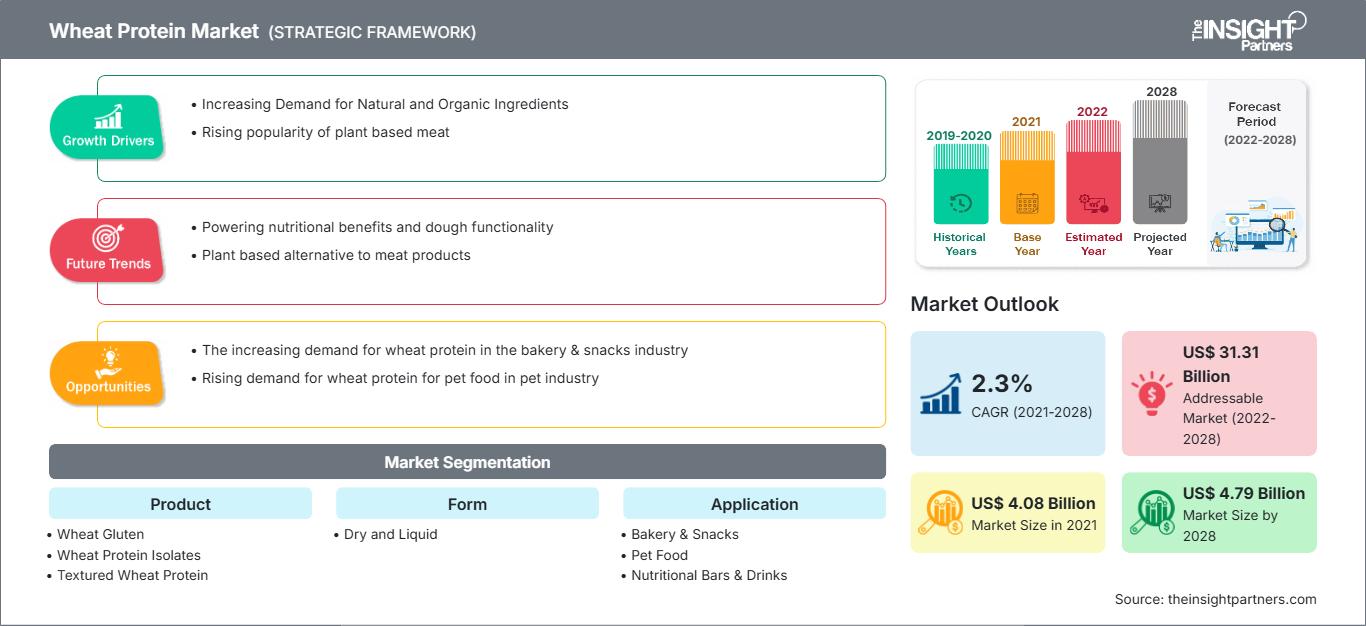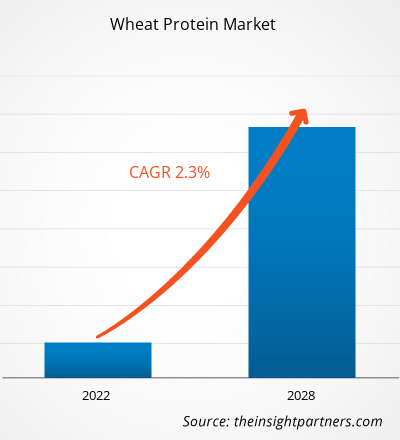[연구 보고서] 밀 단백질 시장은 2021년 40억 8,305만 달러 규모였으며, 2028년에는 47억 8,849만 달러에 이를 것으로 예상됩니다. 2021년부터 2028년까지 연평균 성장률 2.3%로 성장할 것으로 예상됩니다.
밀 단백질은 다양한 효소를 사용하여 밀을 가공하여 얻은 식물성 단백질입니다. 불용성 기능성 단백질로, 독특한 점탄성 특성을 지니고 있으며 최종 제품에 탄성과 신장성을 제공합니다. 이 단백질은 동물성 단백질의 유력한 대안으로 여겨집니다. 제빵 및 제과, 화장품 및 개인 관리, 동물 사료, 영양 보충제 등 다양한 최종 사용 산업에서 널리 사용되고 있습니다.
2020년 유럽은 세계 밀 단백질 시장에서 가장 큰 매출 점유율을 기록했습니다. 유럽 시장은 독일, 프랑스, 이탈리아, 영국, 러시아, 그리고 유럽의 다른 지역으로 구분됩니다. 소비자들의 건강 인식이 높아짐에 따라 콩, 밀, 귀리와 같은 다양한 식물성 단백질 제품에 대한 수요가 증가하고 있습니다. 밀 단백질의 인기는 특히 독일, 프랑스, 영국을 중심으로 유럽 전역에서 증가했습니다. 유럽인들은 육류 섭취의 일부 또는 대부분을 대체 단백질 식품으로 대체하는 플렉시테리언 식단을 점점 더 많이 채택하고 있습니다. 이러한 요인들이 유럽의 밀 단백질 제품 수요를 견인하고 있습니다.
요구 사항에 맞게 이 보고서를 사용자 정의하십시오.
이 보고서의 일부, 국가 수준 분석, Excel 데이터 팩을 포함하여 모든 보고서에 대한 사용자 정의를 무료로 받을 수 있을 뿐만 아니라 스타트업 및 대학을 위한 훌륭한 제안 및 할인을 이용할 수 있습니다
밀 단백질 시장: 전략적 통찰력

-
이 보고서의 주요 주요 시장 동향을 확인하세요.이 무료 샘플에는 시장 동향부터 추정 및 예측에 이르기까지 데이터 분석이 포함됩니다.
식음료 산업을 비롯한 여러 산업이 코로나19 팬데믹으로 인해 전례 없는 어려움에 직면했습니다. 원자재 공급 부족, 공장 폐쇄, 인력 부족, 그리고 코로나19 안전 지침에 따른 운영상의 어려움으로 인해 밀 단백질 제조 관련 기업들은 팬데믹 초기 몇 달 동안 어려움을 겪었습니다. 식음료 산업은 밀 단백질의 주요 소비처이며, 현재 진행 중인 코로나19 팬데믹은 밀 단백질 수요에 부정적인 영향을 미쳤습니다. 슈퍼마켓들이 코로나19 팬데믹으로 인해 재고 우선순위를 주식과 필수품으로 재분배함에 따라 제빵류, 제과류, 유제품과 같은 식음료 제품의 판매가 지연되고 있습니다. 그러나 경제가 회복세를 보이고 있기 때문에 향후 몇 달 동안 전 세계적으로 밀 단백질 수요가 급증할 것으로 예상됩니다. COVID-19 팬데믹으로 건강하고 기능성이 뛰어난 제빵 제품에 대한 수요가 증가했으며, 이는 향후 밀 단백질 시장의 성장을 촉진할 것으로 예상됩니다.
시장 분석
천연 및 유기농 재료에 대한 수요 증가
건강 문제가 심각해지면서 유기농 인증에 대한 인식이 높아지고 고품질 식품에 대한 선호도가 높아지면서 유기농 식품의 중요성이 부각되었습니다. 오늘날 소비자들은 성분, 품질, 그리고 제품 사용 목적을 효과적으로 전달할 수 있는 적절한 라벨이 부착된 자연스럽고 깨끗하며 간편한 재료를 찾고 있습니다. 또한, 소비자들은 유기농 및 천연 식품에 크게 의존하고 있습니다. 예를 들어, 유기농 밀 단백질 소비는 식음료, 동물 및 수산 사료 등 다양한 분야에서 크게 증가하고 있습니다. 따라서 밀 단백질 제조업체들은 유기농 밀 단백질 개발 및 마케팅에 집중하고 있습니다.
제품 분석
제품별로 전 세계 밀 단백질 시장은 밀 글루텐, 밀 단백질 분리물, 조직화 밀 단백질, 가수분해 밀 단백질로 구분됩니다. 2020년에는 밀 글루텐 부문이 가장 큰 매출 점유율을 차지했습니다. 필수 밀 글루텐은 제빵 첨가제로 사용되며, 통밀가루나 호밀가루처럼 글루텐 함량이 낮은 밀가루에 탄력을 더합니다. 또한, 밀 글루텐은 생반죽의 부풀어 오름을 개선하고 최종 제품의 질감과 쫄깃함을 향상시킵니다.
형태 분석
밀 단백질 시장은 형태에 따라 건식과 액상 밀 단백질로 구분됩니다. 2020년에는 건식 밀 단백질 부문이 더 큰 매출 점유율을 차지했습니다. 건조 밀 단백질의 몇 가지 특성으로는 모든 pH 값에서 높은 용해도, 수분 결합 및 유화, 낮은 점도, 그리고 산성 및 열 안정성이 있습니다. 건조 밀 단백질은 제빵, 반려동물 사료, 영양 바, 가공육 및 육류 유사 식품에 점점 더 많이 사용되고 있습니다. 따라서 식품 산업의 광범위한 응용 분야는 건조 부문의 시장 성장을 뒷받침하고 있습니다.
응용 분야 통찰
밀 단백질 시장은 응용 분야별로 제빵 및 스낵, 반려동물 사료, 영양 바 및 음료, 가공육, 육류 유사 식품 등으로 세분화됩니다. 2020년에는 제빵 및 스낵 부문이 가장 큰 매출 점유율을 차지했습니다. 롤, 빵, 쿠키, 페이스트리, 파이, 머핀과 같은 수많은 제빵 제품이 소비자들에게 인기가 많습니다. 밀 단백질은 반죽의 거동을 최적화하고 최종 제품의 영양적 특성을 향상시키는 일반적인 재료 중 하나입니다. 제빵 및 제빵 분야에서 밀 단백질에 대한 수요가 증가하고 있습니다. 스낵 산업과 클린 라벨 트렌드는 전 세계 밀 단백질 시장에서 활동하는 기업들에게 풍부한 기회를 창출하고 있습니다.
Archer Daniels Midland Company, Roquette Frères; Glico Nutrition Co., Ltd; Kröner-Stärke GmbH; Cargill, Incorporated; Crespel & Deiters GmbH & Co. KG; CropEnergies AG; Manildra Group; MGP Ingredients Inc.; 그리고 Tereos Group은 세계 밀 단백질 시장의 몇몇 주요 기업입니다. 이 시장의 기업들은 제품 개발, 공장 확장, 인수합병 등 다양한 전략을 채택하여 전 세계로 사업을 확장하고 증가하는 최종 사용자 수요를 충족하고 있습니다. 예를 들어, Archer Daniels Midland Company는 2020년에 신제품을 개발했습니다. 제품에는 Arcon T 조직 완두콩 단백질, Prolite MeatTEX 조직 밀 단백질, Prolite MeatXT 비조직 밀 단백질이 포함되어 있습니다.
보고서 스포트라이트
- 글로벌 밀 단백질 시장의 진보적인 산업 동향은 플레이어가 효과적인 장기 전략을 개발하는 데 도움이 됩니다.
- 선진국 및 개발도상국 시장에서 채택한 사업 성장 전략
- 2019년부터 2028년까지 글로벌 밀 단백질 시장에 대한 정량적 분석
- 다양한 산업에서 밀 단백질에 대한 수요 추산
- 경쟁 시장 시나리오와 밀 단백질에 대한 수요를 이해하기 위한 최근 개발
- 밀 단백질 시장 성장을 촉진하고 제한하는 요인과 결합된 시장 동향 및 전망
- 글로벌 밀 단백질 시장 성장과 관련하여 상업적 관심을 뒷받침하는 전략을 이해하여 의사 결정 프로세스
- 시장의 다양한 노드에서의 밀 단백질 시장 규모
- 밀 단백질 시장에 대한 자세한 개요 및 세분화 글로벌 밀 단백질 시장과 업계의 역동성
- 다양한 지역의 밀 단백질 시장 규모와 유망한 성장 기회
밀 단백질 시장 지역별 통찰력
The Insight Partners의 분석가들은 예측 기간 동안 밀 단백질 시장에 영향을 미치는 지역별 동향과 요인들을 면밀히 분석했습니다. 이 섹션에서는 북미, 유럽, 아시아 태평양, 중동 및 아프리카, 그리고 중남미 지역의 밀 단백질 시장 부문과 지역별 현황도 살펴봅니다.
밀 단백질 시장 보고서 범위
| 보고서 속성 | 세부 |
|---|---|
| 시장 규모 2021 | US$ 4.08 Billion |
| 시장규모별 2028 | US$ 4.79 Billion |
| 글로벌 CAGR (2021 - 2028) | 2.3% |
| 이전 데이터 | 2019-2020 |
| 예측 기간 | 2022-2028 |
| 다루는 세그먼트 |
By 제품
|
| 포함된 지역 및 국가 |
북미
|
| 시장 선도 기업 및 주요 회사 프로필 |
|
밀 단백질 시장 참여자 밀도: 비즈니스 역학에 미치는 영향 이해
밀 단백질 시장은 소비자 선호도 변화, 기술 발전, 그리고 제품의 효능에 대한 인식 제고 등의 요인으로 최종 사용자 수요가 증가함에 따라 빠르게 성장하고 있습니다. 수요가 증가함에 따라 기업들은 제품 라인업을 확장하고, 소비자 니즈를 충족하기 위한 혁신을 추진하며, 새로운 트렌드를 적극 활용하고 있으며, 이는 시장 성장을 더욱 가속화하고 있습니다.

- 을 얻으세요 밀 단백질 시장 주요 주요 플레이어 개요
밀 단백질 시장:
- 제품
- 밀 글루텐
- 분리 밀 단백질
- 질감 있는 밀 단백질
- 가수분해된 밀 단백질
밀 단백질 시장: 형태
- 건조
- 액체
밀 단백질 시장, 용도별
- 베이커리 및amp; 스낵
- 애완동물 사료
- 영양 바 & 음료
- 가공육
- 육류 유사식품
- 기타
회사 프로필
- Archer Daniels Midland Company
- Roquette Frères
- Glico Nutrition Co.,Ltd
- Kröner-Stärke GmbH
- Cargill, Incorporated
- Crespel & Deiters GmbH & Co. KG
- CropEnergies AG
- Manildra Group
- MGP Ingredients Inc.
- Tereos Group
- 과거 분석(2년), 기준 연도, CAGR을 포함한 예측(7년)
- PEST 및 SWOT 분석
- 시장 규모 가치/거래량 - 글로벌, 지역, 국가
- 산업 및 경쟁 환경
- Excel 데이터세트
최근 보고서
사용 후기
구매 이유
- 정보에 기반한 의사 결정
- 시장 역학 이해
- 경쟁 분석
- 고객 인사이트
- 시장 예측
- 위험 완화
- 전략 기획
- 투자 타당성 분석
- 신흥 시장 파악
- 마케팅 전략 강화
- 운영 효율성 향상
- 규제 동향에 발맞춰 대응






















 무료 샘플 받기 - 밀 단백질 시장
무료 샘플 받기 - 밀 단백질 시장